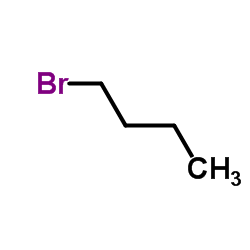92273-73-9
| 中文名 | 丁基溴化锌 |
|---|---|
| 英文名 | butylzinc bromide |
| 中文别名 | 正丁基溴化锌 |
| 英文别名 |
Butylzinc bromide solution 0.5 in THF
n-Butylzinc broMide,0.5M in THF,packaged under Argon in resealable CheMSeal^t bottles butylzinc(II) bromide MFCD00671997 n-butylZnBr butylzinc bromide solution |
| 密度 | 0.958g/mLat 25℃ |
|---|---|
| 分子式 | C4H9BrZn |
| 分子量 | 202.39800 |
| 闪点 | 1°F |
| 精确质量 | 199.91800 |
| LogP | 2.59720 |
| 储存条件 | 2-8℃ |
| 稳定性 | 不稳定 避免接触强氧化剂 |
| 更多 | 1. 性状:无色透明液体 2. 密度(g/mL 25ºC):0.958 3. 相对蒸汽密度(g/mL,空气=1):未确定 4. 熔点(ºC常压):未确定 5. 沸点(ºC):未确定 6. 沸点(ºC,5.2kPa):未确定 7. 折射率(n20/D):未确定 8. 闪点(ºC,):-17 9. 比旋光度(º):未确定 10. 自燃点或引燃温度(ºC):未确定 11. 蒸气压(kPa,25ºC):未确定 12. 饱和蒸气压(kPa,60ºC):未确定 13. 燃烧热(KJ/mol):未确定 14. 临界温度(ºC):未确定 15. 临界压力(KPa):未确定 16. 油水(辛醇/水)分配系数的对数值(25℃):未确定 17. 爆炸上限(%,V/V):未确定 18. 爆炸下限(%,V/V):未确定 19. 溶解性(mg/mL) :未确定 |
|
SECTION 1: Identification of the substance/mixture and of the company/undertaking Product identifiers Product name: Butylzinc bromide solution REACH No.: A registration number is not available for this substance as the substance or its uses are exempted from registration, the annual tonnage does not require a registration or the registration is envisaged for a later registration deadline.
Relevant identified uses of the substance or mixture and uses advised against Identified uses: Laboratory chemicals, Manufacture of substances SECTION 2: Hazards identification Classification of the substance or mixture Classification according to Regulation (EC) No 1272/2008 Flammable liquids (Category 2), H225 Eye irritation (Category 2), H319 Carcinogenicity (Category 2), H351 Specific target organ toxicity - single exposure (Category 3), Respiratory system, H335 For the full text of the H-Statements mentioned in this Section, see Section 16. Classification according to EU Directives 67/548/EEC or 1999/45/EC F Highly flammableR11 Xn HarmfulR40 Xi IrritantR36/37 R19 For the full text of the R-phrases mentioned in this Section, see Section 16. Label elements Labelling according Regulation (EC) No 1272/2008 Pictogram Signal wordDanger Hazard statement(s) H225Highly flammable liquid and vapour. H319Causes serious eye irritation. H335May cause respiratory irritation. H351Suspected of causing cancer. Precautionary statement(s) P210Keep away from heat/sparks/open flames/hot surfaces. - No smoking. P261Avoid breathing vapours. P281Use personal protective equipment as required. P305 + P351 + P338IF IN EYES: Rinse cautiously with water for several minutes. Remove contact lenses, if present and easy to do. Continue rinsing. Supplemental Hazard information (EU) EUH019May form explosive peroxides. According to European Directive 67/548/EEC as amended. Hazard symbol(s)F Highly flammable Xn Harmful R-phrase(s) R11Highly flammable. R19May form explosive peroxides. R36/37Irritating to eyes and respiratory system. R40Limited evidence of a carcinogenic effect. S-phrase(s) S16Keep away from sources of ignition - No smoking. S26In case of contact with eyes, rinse immediately with plenty of water and seek medical advice. S36/37Wear suitable protective clothing and gloves. Other hazards - none SECTION 3: Composition/information on ingredients Mixtures Formula: C4H9BrZn Molecular Weight: 202,41 g/mol Hazardous ingredients according to Regulation (EC) No 1272/2008 ComponentClassificationConcentration Tetrahydrofuran CAS-No.109-99-9Flam. Liq. 2; Eye Irrit. 2; Carc.50 - 100 % EC-No.203-726-82; STOT SE 3; H225, H319, Index-No.603-025-00-0H335, H351, EUH019 Registration number01-2119444314-46-XXXX Hazardous ingredients according to Directive 1999/45/EC ComponentClassificationConcentration Tetrahydrofuran CAS-No.109-99-9F, Xn, Carc.Cat.3, R11 - R19 -50 - 100 % EC-No.203-726-8R40 - R36/37 Index-No.603-025-00-0 Registration number01-2119444314-46-XXXX For the full text of the H-Statements and R-Phrases mentioned in this Section, see Section 16 SECTION 4: First aid measures Description of first aid measures General advice Consult a physician. Show this safety data sheet to the doctor in attendance. If inhaled If breathed in, move person into fresh air. If not breathing, give artificial respiration. Consult a physician. In case of skin contact Wash off with soap and plenty of water. Consult a physician. In case of eye contact Rinse thoroughly with plenty of water for at least 15 minutes and consult a physician. If swallowed Do NOT induce vomiting. Never give anything by mouth to an unconscious person. Rinse mouth with water. Consult a physician. Most important symptoms and effects, both acute and delayed The most important known symptoms and effects are described in the labelling (see section 2.2) and/or in section 11 Indication of any immediate medical attention and special treatment needed no data available SECTION 5: Firefighting measures Extinguishing media Suitable extinguishing media Use water spray, alcohol-resistant foam, dry chemical or carbon dioxide. Special hazards arising from the substance or mixture Carbon oxides Advice for firefighters Wear self contained breathing apparatus for fire fighting if necessary. Further information Use water spray to cool unopened containers. SECTION 6: Accidental release measures Personal precautions, protective equipment and emergency procedures Use personal protective equipment. Avoid breathing vapours, mist or gas. Ensure adequate ventilation. Remove all sources of ignition. Evacuate personnel to safe areas. Beware of vapours accumulating to form explosive concentrations. Vapours can accumulate in low areas. For personal protection see section 8. Environmental precautions Prevent further leakage or spillage if safe to do so. Do not let product enter drains. Methods and materials for containment and cleaning up Contain spillage, and then collect with an electrically protected vacuum cleaner or by wet-brushing and place in container for disposal according to local regulations (see section 13). Reference to other sections For disposal see section 13. SECTION 7: Handling and storage Precautions for safe handling Avoid contact with skin and eyes. Avoid inhalation of vapour or mist. Keep away from sources of ignition - No smoking.Take measures to prevent the build up of electrostatic charge. For precautions see section 2.2. Conditions for safe storage, including any incompatibilities Store in cool place. Keep container tightly closed in a dry and well-ventilated place. Containers which are opened must be carefully resealed and kept upright to prevent leakage. Recommended storage temperature: 2 - 8 °C Handle and store under inert gas. Handle and open container with care. Dry residue is explosive. Specific end use(s) Apart from the uses mentioned in section 1.2 no other specific uses are stipulated SECTION 8: Exposure controls/personal protection Control parameters Components with workplace control parameters Exposure controls Appropriate engineering controls Handle in accordance with good industrial hygiene and safety practice. Wash hands before breaks and at the end of workday. Personal protective equipment Eye/face protection Face shield and safety glasses Use equipment for eye protection tested and approved under appropriate government standards such as NIOSH (US) or EN 166(EU). Skin protection Handle with gloves. Gloves must be inspected prior to use. Use proper glove removal technique (without touching glove's outer surface) to avoid skin contact with this product. Dispose of contaminated gloves after use in accordance with applicable laws and good laboratory practices. Wash and dry hands. The selected protective gloves have to satisfy the specifications of EU Directive 89/686/EEC and the standard EN 374 derived from it. Body Protection Complete suit protecting against chemicals, Flame retardant antistatic protective clothing, The type of protective equipment must be selected according to the concentration and amount of the dangerous substance at the specific workplace. Respiratory protection Where risk assessment shows air-purifying respirators are appropriate use a full-face respirator with multi-purpose combination (US) or type ABEK (EN 14387) respirator cartridges as a backup to engineering controls. If the respirator is the sole means of protection, use a full-face supplied air respirator. Use respirators and components tested and approved under appropriate government standards such as NIOSH (US) or CEN (EU). Control of environmental exposure Prevent further leakage or spillage if safe to do so. Do not let product enter drains. SECTION 9: Physical and chemical properties Information on basic physical and chemical properties a) AppearanceForm: clear, liquid Colour: colourless b) Odourno data available c) Odour Thresholdno data available d) pHno data available e) Melting point/freezingno data available point f) Initial boiling point and no data available boiling range g) Flash point-17 °C - closed cup h) Evapouration rateno data available i) Flammability (solid, gas) no data available j) Upper/lowerno data available flammability or explosive limits k) Vapour pressureno data available l) Vapour densityno data available m) Relative density0,958 g/cm3 n) Water solubilityno data available o) Partition coefficient: n- no data available octanol/water p) Auto-ignitionno data available temperature q) Decompositionno data available temperature r) Viscosityno data available s) Explosive propertiesno data available t) Oxidizing propertiesno data available Other safety information no data available SECTION 10: Stability and reactivity Reactivity no data available Chemical stability Stable under recommended storage conditions. Possibility of hazardous reactions no data available Conditions to avoid Heat, flames and sparks. Extremes of temperature and direct sunlight. Incompatible materials Oxidizing agents, Oxygen Hazardous decomposition products Other decomposition products - no data available In the event of fire: see section 5 SECTION 11: Toxicological information Information on toxicological effects Acute toxicity no data available Skin corrosion/irritation no data available Serious eye damage/eye irritation no data available Respiratory or skin sensitisation no data available Germ cell mutagenicity no data available Carcinogenicity IARC:No component of this product present at levels greater than or equal to 0.1% is identified as probable, possible or confirmed human carcinogen by IARC. Reproductive toxicity no data available Specific target organ toxicity - single exposure no data available Specific target organ toxicity - repeated exposure no data available Aspiration hazard no data available Additional Information RTECS: Not available Central nervous system depression, Cough, chest pain, Difficulty in breathing, Exposure to high airborne concentrations can cause anesthetic effects., To the best of our knowledge, the chemical, physical, and toxicological properties have not been thoroughly investigated. To the best of our knowledge, the chemical, physical, and toxicological properties have not been thoroughly investigated. SECTION 12: Ecological information Toxicity no data available Persistence and degradability no data available Bioaccumulative potential no data available Mobility in soil no data available Results of PBT and vPvB assessment PBT/vPvB assessment not available as chemical safety assessment not required/not conducted Other adverse effects no data available SECTION 13: Disposal considerations Waste treatment methods Product Burn in a chemical incinerator equipped with an afterburner and scrubber but exert extra care in igniting as this material is highly flammable. Offer surplus and non-recyclable solutions to a licensed disposal company. Contaminated packaging Dispose of as unused product. SECTION 14: Transport information UN number ADR/RID: 2924IMDG: 2924IATA: 2924 UN proper shipping name ADR/RID: FLAMMABLE LIQUID, CORROSIVE, N.O.S. (Tetrahydrofuran, Butylzinc bromide) IMDG: FLAMMABLE LIQUID, CORROSIVE, N.O.S. (Butylzinc bromide, Tetrahydrofuran) IATA:Flammable liquid, corrosive, n.o.s. (Butylzinc bromide, Tetrahydrofuran) Transport hazard class(es) ADR/RID: 3 (8)IMDG: 3 (8)IATA: 3 (8) Packaging group ADR/RID: IIIMDG: IIIATA: II Environmental hazards ADR/RID: noIMDG Marine pollutant: noIATA: no Special precautions for user no data available SECTION 15 - REGULATORY INFORMATION N/A SECTION 16 - ADDITIONAL INFORMATION N/A |
| 危害码 (欧洲) | F: Flammable;Xn: Harmful; |
|---|---|
| 风险声明 (欧洲) | 11-14-19-22-36/37/38-40 |
| 安全声明 (欧洲) | 16-26-33-36 |
| 危险品运输编码 | UN 3399 4.3/PG 2 |
| 海关编码 | 2931900090 |
|
~98% 
92273-73-9 |
| 文献:Lang, Sebastian; Murso, Alexander; Wietelmann, Ulrich Patent: US2009/118529 A1, 2009 ; Location in patent: Page/Page column 9 ; |
|
~% 
92273-73-9 |
| 文献:Journal of Organometallic Chemistry, , vol. 362, p. 237 - 242 |
| 海关编码 | 2931900090 |
|---|---|
| 中文概述 | 2931900090. 其他有机-无机化合物. 增值税率:17.0%. 退税率:13.0%. 监管条件:AB(入境货物通关单,出境货物通关单). 最惠国关税:6.5%. 普通关税:30.0% |
| Summary | 2931900090. other organo-inorganic compounds. VAT:17.0%. Tax rebate rate:13.0%. Supervision conditions:AB(certificate of inspection for goods inward,certificate of inspection for goods outward). MFN tariff:6.5%. General tariff:30.0% |



